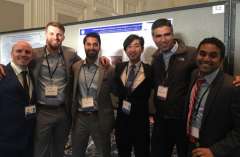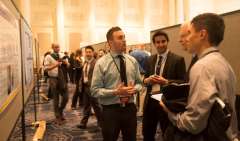Anesthesiology Resident Scholars Program (ARSP)
This competitive 60-month program is intended to train future clinician scientists dedicated to advancing research in anesthesiology. The program will be outlined and discussed during the residency interview day, and information will be provided to residency applicants electronically. Potential Resident Scholars will be identified early during residency recruitment. (Please see “Application Process” below.)
A maximum of one to two applicants per year will be accepted to this program. Participants will receive a yearly $10,000 stipend starting in the PGY-2 year for the duration of their residency and fellowship. All ARSP scholars will be required to submit to and present at our Annual Scientific Evening, WARC, and regional and appropriate national society meetings (ASA, SCA, SCA, ASRA, SOAP, etc.), with departmental support each year.

- CBY or PGY-1: The resident will complete all required rotations according to the standard residency track. With the guidance of the Residency Program leadership, residents should identify possible research interests and mentors early on in the PGY-1 year.
- PGY-2 to PGY-3: With the guidance of the Residency Program leadership, the resident should identify research interest and a mentor within the first six months, and submit a formal research project proposal to the Clinical Research Committee (CRC) by the middle of the PGY-2 year. The resident should have regular meetings with research mentors at least every month. Up to 3 months may be allowed for dedicated research in the PGY-2 to PGY-3 years. Projects will be evaluated for progress every six months by the CRC.
- PGY-4: The resident will have up to 6 months of dedicated research time. The resident should meet with research mentors monthly. During this year, residents should have at least one manuscript in submission or published, and should apply for a FAER grant (or other comparable grant). A special commendation will be noted at graduation for all residents who are in the Anesthesiology Resident Scholars Program.
- PGY-5/Research Fellow: During this year, ARSP scholars will be expected to spend at least 35% of their time in research. They will be required to meet with their mentors monthly. Abstract submission and presentation at our Annual Scientific Evening, WARC, and national/regional society meetings remain mandatory. Fellows will continue to hone their clinical skills with appointment at the Clinical Instructor level.
Residents in the ARSP must demonstrate excellence in clinical skill and medical knowledge, as demonstrated by maintaining good academic standing as per departmental education policy. In addition, the resident must pass all milestones and receive satisfactory evaluations. The resident may be allowed to schedule the Basic Examination on an alternate schedule at the discretion of the Program Director. Residents must take the standard complement of call during their research months.
The Clinical Research Committee (CRC) will also evaluate resident progress.
Upon completion of the Resident Scholars Program, and dependent upon overall satisfactory performance, the fellow will be offered a position as Assistant Clinical Professor within the UCLA Department of Anesthesiology and Perioperative Medicine.
Application Process

- Potential candidates will be identified during residency recruitment and encouraged to apply to the program. In addition to submitting their anesthesia residency application through ERAS, potential applicants must submit the following:
- A summary of research background, interests, and publications
- A career development plan
- 2 letters of reference, preferably from faculty familiar with the candidate’s research work.
- Applications will be reviewed by the Chair, Residency Program leadership, and CRC, and ranked in order of strength of application.
- Top candidates will be notified by the Residency Program leadership prior to the NRMP match that they will be highly ranked.
- If these candidates do not match to the residency, the residency program leadership may offer the position to the next qualified candidate, or may not offer the program to any candidate for that year.
- 1-2 residents per year will be accepted into this program.